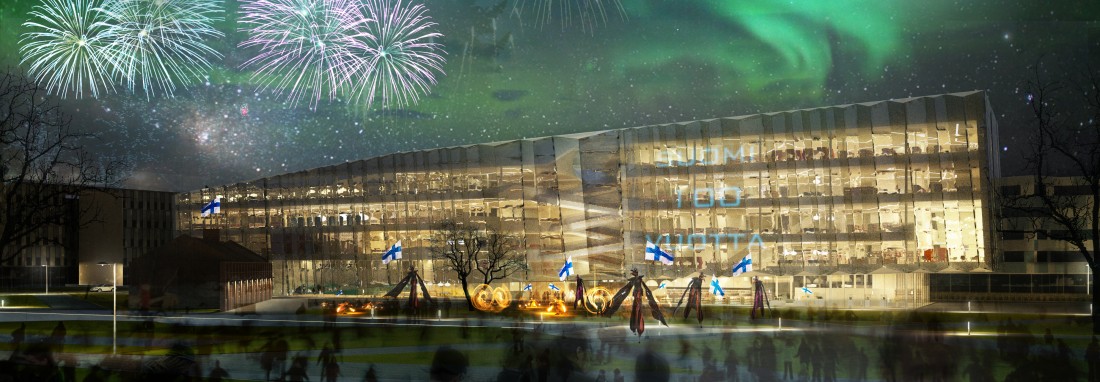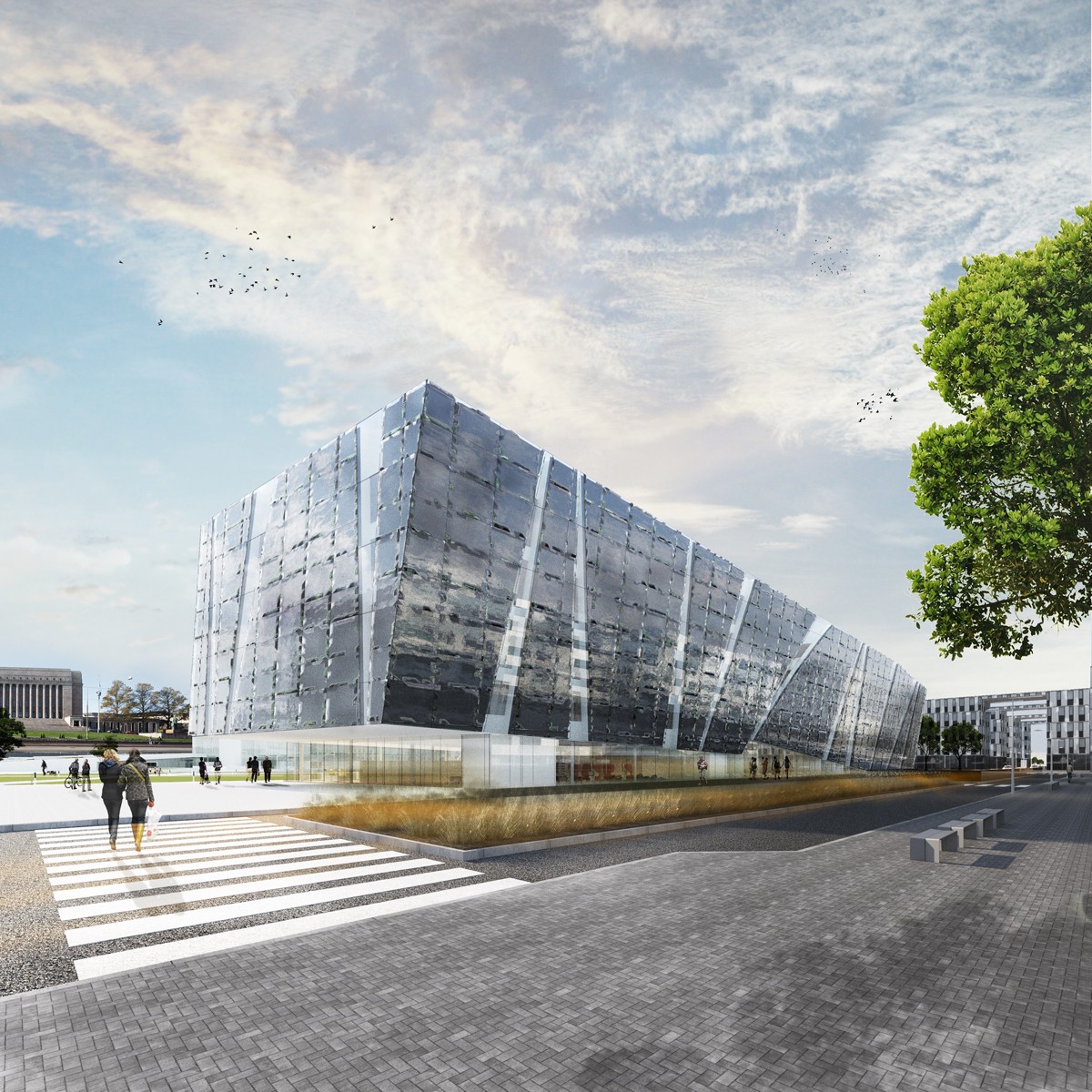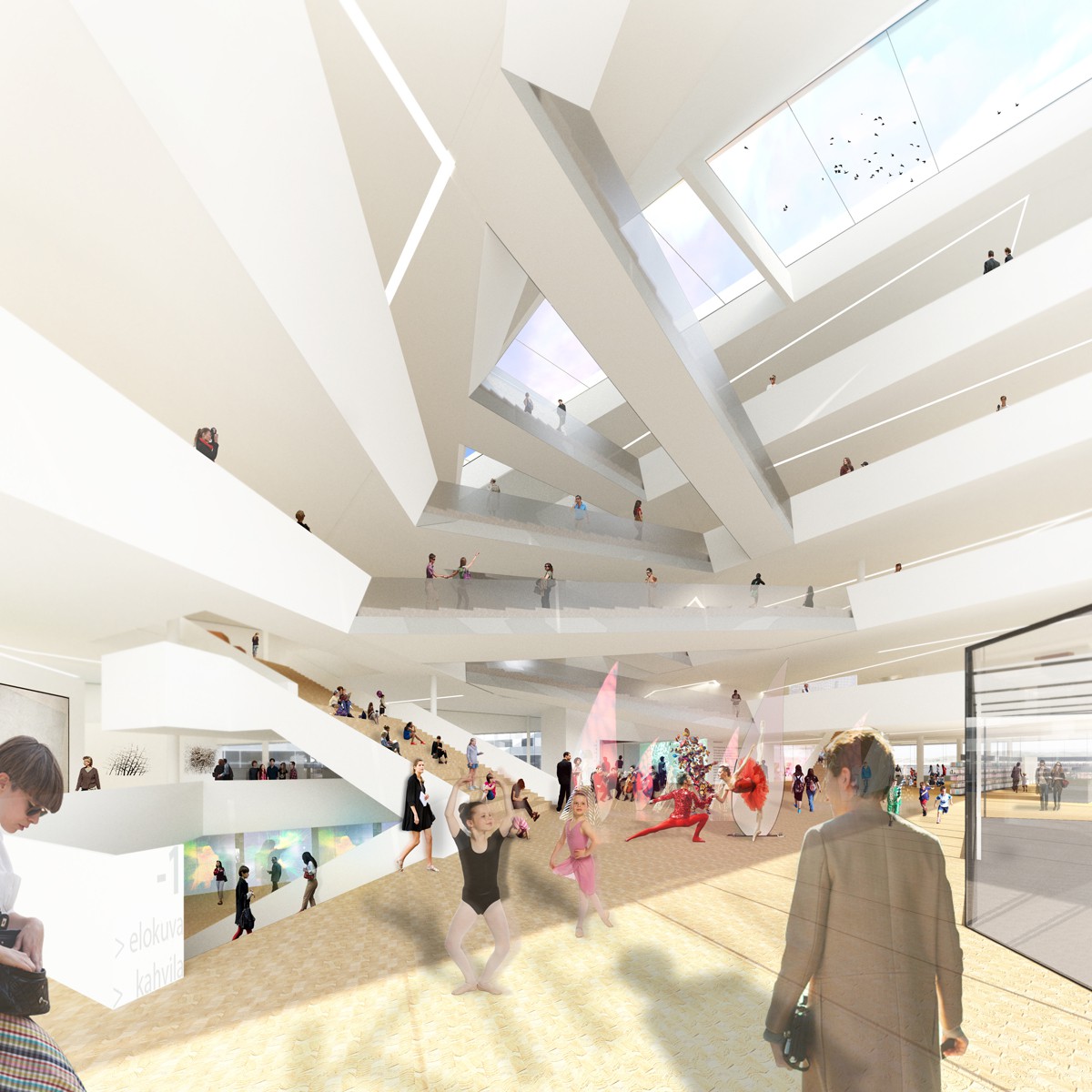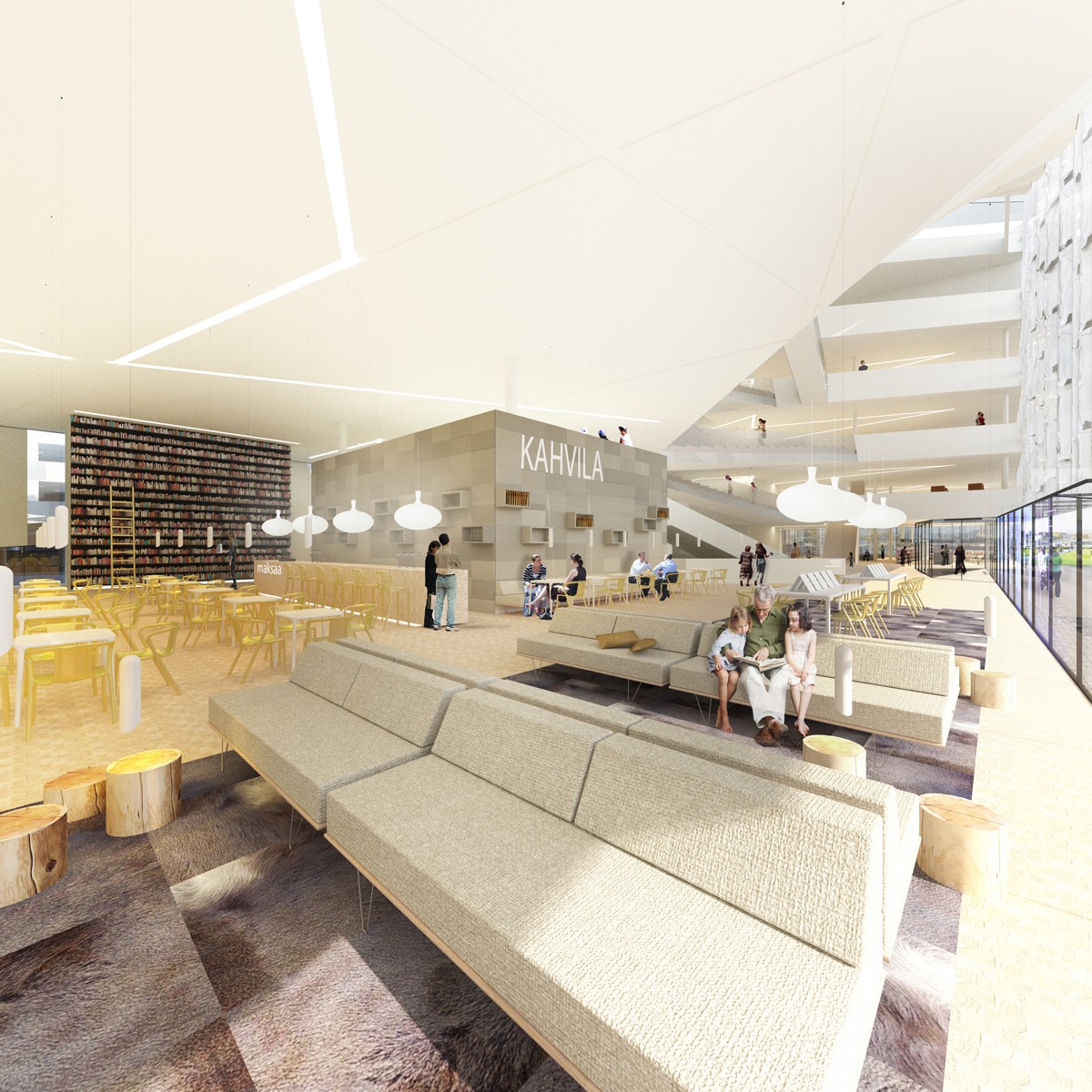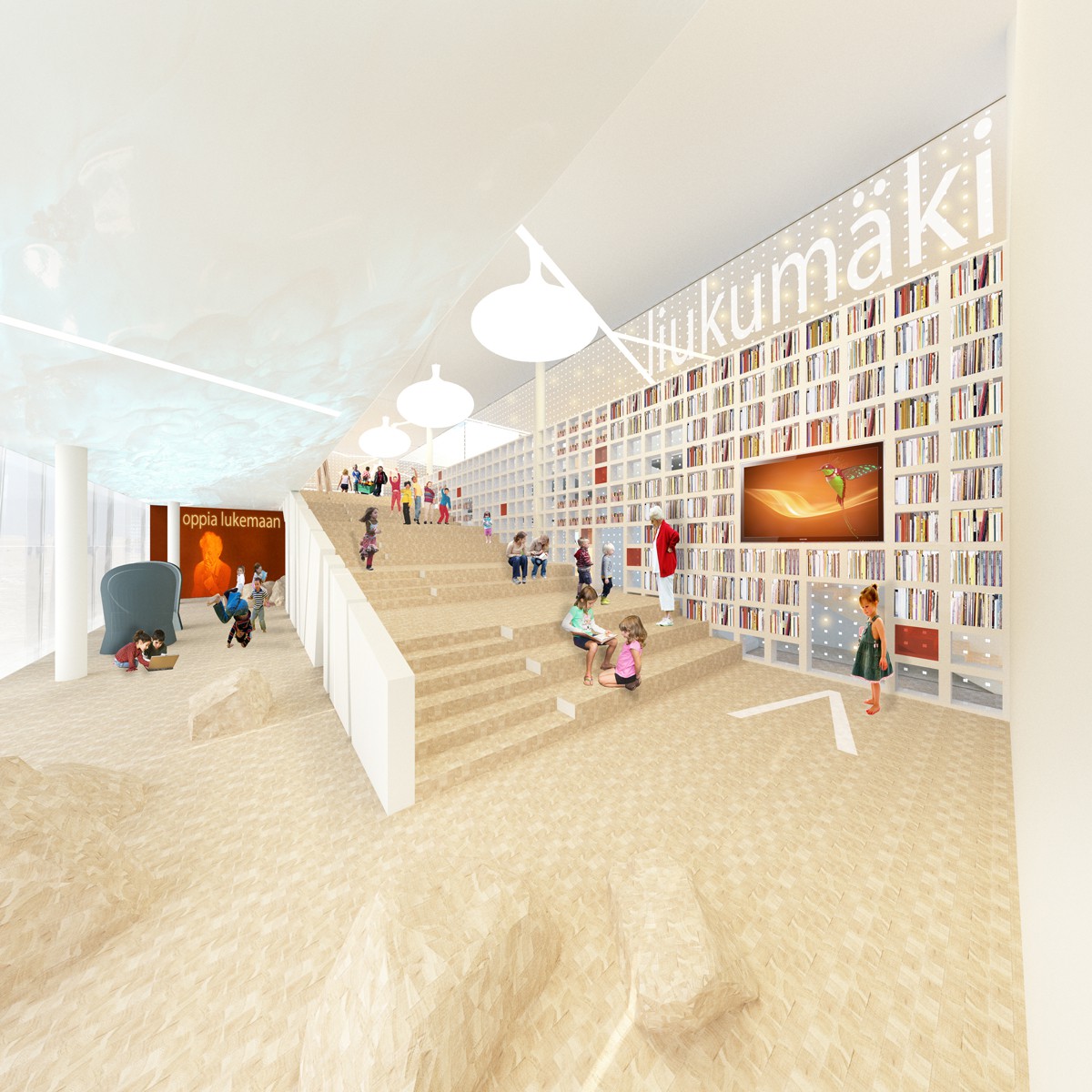The results of the first stage of the international architecture competition for a new Helsinki Central Library have been presented. Out of 544 entries 6 proposals competed in the second stage to win this project.
Atelier PRO designed the ‘Northern Lights’ in collaboration with the Finish practice Uki Arkkitehdit, Buro Happold and LVI-Sasto Oy. The building reacts on the wintery elements of snow and ice. Located on the edge of the Töölönlahti park, the public library of Helsinki reveals itself as an anchored block of pack ice drifted from the Töölönlahti bay. Our submission was not selected.
The winner of "the heart of the metropolis' is ALA Architects with the submission Käännös.
More informations about our design:
Northern Lights in icy shapes
Inspired by the Finnish winters of snow and ice, and located on the edge of the Töölönlahti Park, the public library of Helsinki reveals itself as an anchored block of pack ice drifted from the Töölönlahti bay. The long and slender volume lies as a sharp-edged, transparent cube in the low angled sun.
The icy surface of the library seems to be affected by the elements. Its form is dictated by how the surrounding building blocks control the relatively low sun angles and wind patterns. By their means the cube has been flattened and is worn down at the north side, as if it cuts to the surface underneath. At the central point of the long volume, whirling gusts of wind carve through the ice. As a result the icy facade has been eroded into a vertical pattern of prismatic shapes mirroring the sun.
Prism facade + Smart glass
The eye-catching prisms on the entire west facade are a part of the passive energy concept. The prism shape, in combination with the use of Smart glass, is an efficient way to prevent excessive sun radiation and at the same time allows for astonishing views of the surroundings all day. Smart glass can be changed from translucent to transparent with a small electric impulse provided by micro solar panels, or PV-cells. In summertime the south side of the prisms will be translucent until noon, while the north side stays transparent. When the sun touches the north side of the prisms, the principle works the other way around. The diffuse effect contributes to a light and pleasant atmosphere to read or work with digital screens.
The Crevasse - entrance and circulation
As the library building is a slender cube of over 130 meters covered by prisms, the main entrance forms the breakpoint through an intriguing crevasse as the center point of the building. Seen from the outside, it sharply frames the main public functions and activities. The crevasse simply exists out of two entities of stacked floor slabs, reacting on each other by a split level system. Both edges are rotated on different angles whereby the axes are perpendicular to important sightlines in the environment.
Main lobby – crevasse
The entrance is conducted by large prismatic entities, which suppress towards the corners of the library. The entrance leads directly to the main lobby, in which the crevasse reveals itself as a spatial and easily perceived center of the library. In this central area, people can sit on the stairs and listen to writers reciting their work, or enjoy improvised art from a theatre group. To ensure that the crevasse is bathed in daylight, heliostats are hung at the edge close to the roof lights.
Library collection space
The collection area spreads throughout the entire building. The basement is in direct connection with the main lobby and is reserved for youngsters. It is possible to make a connection from here to the future underground multipurpose space. The first floor, to the south of the crevasse, is reserved for client workrooms and a variety of meeting spaces and rooms. This floor also holds the newspaper and magazine department. The library collection is sandwiched by the event spaces on the basement and ground floors, and the restaurant, sauna spaces and roof terrace on the third and fourth floors. The loud spaces are in the center of the building around the crevasse. The further away from the crevasse, the quieter the space.
Children’s World
The different Children’s World areas are positioned in relation to the child’s age. On the first floor, the grandstand, or landscape staircase, accompany the different age groups to their desired activity spaces. The most adventurist space revolves around the children's book case. The book case is a lightweight, two storey high framed wall, with the stairs on one side and a slide on the other. Children can climb or walk up the grandstand and crawl through several holes in the book case along their way to reach either the slide or the “secret” adventure spaces. The glazed side wall of the slide provides a direct visual connection with the library collection area.
Sightlines
The building and the outline of the crevasse are carefully implemented into the urban fabric by following the sightlines of the surrounding buildings.The overall building volume slopes upwards towards the Sanomatalo. The ground floor of the south facade is set back, thereby creating a larger square at the south side of the site. In combination with the sloped, cantilevered building volume, this is an inviting gesture to pedestrians coming from the station, the Töölönlahti Park and the main access route across the Kansalaistori piazza.
The west facade of the library is fully glazed and opens up towards the park. The ‘curtain’ of prisms is lifted up to the first floor level and reveals a plinth of clear recycled glass that creates a direct connection between the interior and the public space around the library. An extra entrance to the underground multipurpose space is shaped like a stepped terrace area in front of the library café. Next to this underground space it will be possible to connect the underground service area of the library with the underground service area of the Helsinki Music Centre in the future.
Energy production
Energy production will be implemented through solar energy, absorption cooling by solar energy, electricity from solar energy, air heat recovery from the City-tunnel exhaust, and heat recovery from the refrigeration machinery en cogeneration.

